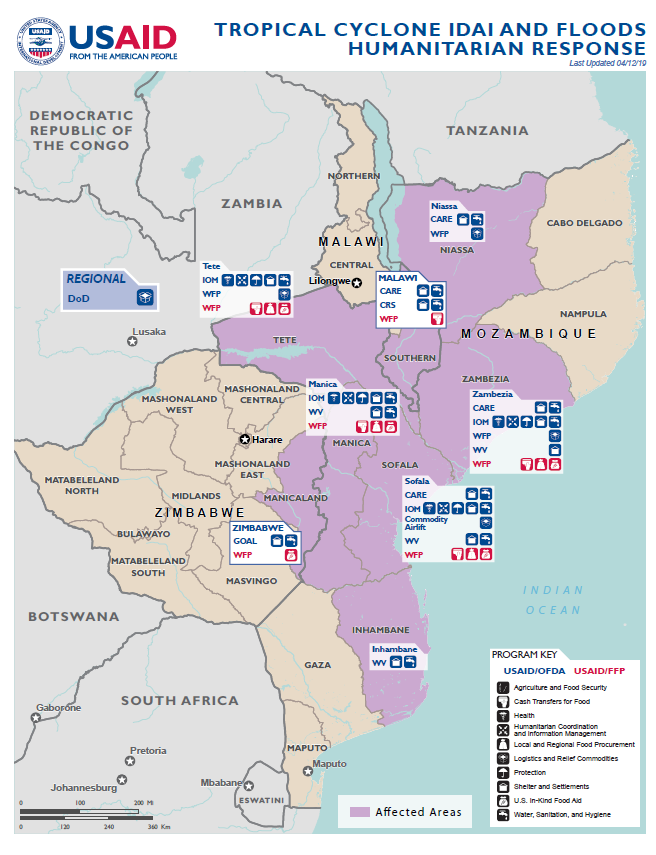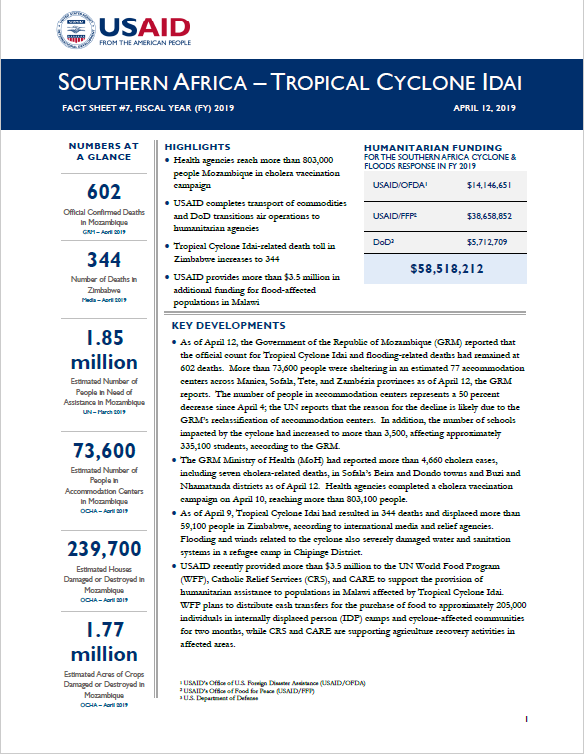Speeches Shim
April 12, 2019
Numbers At A Glance
602
344
1.85 million
73,600
239,700
1.77 million
Humanitarian Funding
FOR THE SOUTHERN AFRICA CYCLONE & FLOODS RESPONSE IN FY 2019
| USAID/FFP | $38,658,852 |
| USAID/OFDA | $14,146,651 |
| DoD | $5,712,709 |
| TOTAL | $58,518,212 |
Highlights
- Health agencies reach more than 803,000 people Mozambique in cholera vaccination campaign
- USAID completes transport of commodities and DoD transitions air operations to humanitarian agencies
- Tropical Cyclone Idai-related death toll in Zimbabwe increases to 344
- USAID provides more than $3.5 million in additional funding for flood-affected populations in Malawi
Key Developments
As of April 12, the Government of the Republic of Mozambique (GRM) reported that the official count for Tropical Cyclone Idai and flooding-related deaths had remained at 602 deaths. More than 73,600 people were sheltering in an estimated 77 accommodation centers across Manica, Sofala, Tete, and Zambézia provinces as of April 12, the GRM reports. The number of people in accommodation centers represents a 50 percent decrease since April 4; the UN reports that the reason for the decline is likely due to the GRM’s reclassification of accommodation centers. In addition, the number of schools impacted by the cyclone had increased to more than 3,500, affecting approximately 335,100 students, according to the GRM.
The GRM Ministry of Health (MoH) had reported more than 4,660 cholera cases, including seven cholera-related deaths, in Sofala’s Beira and Dondo towns and Buzi and Nhamatanda districts as of April 12. Health agencies completed a cholera vaccination campaign on April 10, reaching more than 803,100 people.
As of April 9, Tropical Cyclone Idai had resulted in 344 deaths and displaced more than 59,100 people in Zimbabwe, according to international media and relief agencies. Flooding and winds related to the cyclone also severely damaged water and sanitation systems in a refugee camp in Chipinge District.
USAID recently provided more than $3.5 million to the UN World Food Program (WFP), Catholic Relief Services (CRS), and CARE to support the provision of humanitarian assistance to populations in Malawi affected by Tropical Cyclone Idai. WFP plans to distribute cash transfers for the purchase of food to approximately 205,000 individuals in internally displaced person (IDP) camps and cyclone-affected communities for two months, while CRS and CARE are supporting agriculture recovery activities in affected areas.
MOZAMBIQUE
Humanitarian Response and Gaps
As of April 12, the GRM had reported more than 4,660 cholera cases and seven cholera-related deaths in Beira, Buzi, Dondo, and Nhamantanda. To prevent the spread of the disease, the MoH, the UN Children’s Fund (UNICEF), and the UN World Health Organization (WHO) conducted a cholera vaccination campaign from April 3–10, reaching more than 803,100 people, or 95 percent of the targeted population. In addition, health and water, sanitation, and hygiene (WASH) agencies are working to identify ways to support cholera treatment and prevention activities.
The UN has also reported nearly 8,900 malaria cases in Beira, Buzi, Dondo, and Nhamantanda since March 27, with nearly 40 percent of cases reported in Nhamatanda. In response, relief agencies are planning to distribute mosquito nets in the coming days.
In collaboration with the Camp Coordination and Camp Management (CCCM) Cluster, the International Organization for Migration (IOM) Displacement Tracking Matrix (DTM) conducted surveys to determine displaced populations’ intentions to leave or remain in accommodations centers in Beira, Dondo, and Nhamatanda. According to the surveys, the majority of displaced individuals expect to return to areas of origin in less than two months. Assessed individuals also reported that damage or destruction to homes was a major reason for delayed returns. Displaced interviewees cited food, shelter, and latrines as the most acute humanitarian needs and noted barriers to health care services, such as limited service hours and a lack of medical supplies.
The CCCM Cluster developed and circulated guidance to outline relocation practices and processes that meet international standards. The Protection Cluster is also conducting various assessments in the affected areas, identifying a number of protection risks and needs, and plans to share the full report with all humanitarian clusters in the coming days.
USG Response and Assessments
On April 12, the last of eight USAID-chartered flights transporting commodities from USAID’s warehouses in Pisa, Itlay, and Dubai, UAE arrived in Beira. In total, the flights transported more than 700 metric tons (MT) of emergency relief commodities, including kitchen sets, plastic sheeting, and water treatment units, to support cyclone-affected populations in Mozambique. In addition, demand for DoD’s unique capabilities to transport humanitarian commodities has ceased as road access has improved and commercial flights have resumed. As a result, DoD transitioned air support operations to humanitarian agencies on April 12.
USAID Disaster Assistance Response Team (DART) health and WASH advisors conducted an assessment in Manica’s Sussundenga District, an area heavily impacted by flooding, on April 10. Overall, there was limited visible damage to buildings and homes in areas outside Manica’s Chimoio town; however, in low-lying river valleys, DART members observed flood debris, indicating that flood waters were significant in some areas immediately following the cyclone’s landfall.
DART members met with Save the Children (SC) and conducted site visits to two mobile clinics operating in flood-affected areas. Health care providers noted that a majority of clinical consultations were for malaria, with 50 percent of patients with a fever testing positive for malaria. Health care workers are providing basic services, including malaria testing and treatment and pre-natal care for pregnant women, at both sites. Local health authorities also provided vaccines to one of the mobile clinics, enabling routine vaccinations to be offered to children younger than five years of age.
In one of SC’s mobile clinics in Sussundenga’s Máquina town, where approximately 245 flood-affected households had been resettled from a nearby school that was serving as an accommodation center, community members reported that the landowner had asked the households to relocate to a third site. A relief organization is delivering chlorinated water to the settlement twice a day and COSACA—a consortium of humanitarian organizations operating in the affected areas—is also providing Certeza—a water treatment agent—to populations at the site. COSACA also provided materials for the community to build an estimated 27 latrines, although DART members observed only one hand-washing station that SC had provided and placed outside latrines closest to where health workers were providing services.
ZIMBABWE
Current Situation
The death toll from Tropical Cyclone Idai in Zimbabwe had increased to 344 as of April 9, according to international media. The storm also displaced more than 59,100 individuals across Buhera, Chimanmani, Chipinge, and Mutare districts, IOM reports.
The Office of the UN High Commissioner for Refugees (UNHCR) reported a shortage of safe drinking water in Chipinge District’s Tongogara refugee camp, where more than 13,000 refugees and asylum seekers resided as of April 10. Flooding and winds related to Tropical Cyclone Idai severely damaged water and sanitation systems, as well as approximately 1,200 dwellings, in the camp. In response, UNHCR is transporting relief commodities—including blankets, kitchen sets, jerry cans, mosquito nets, sanitary supplies, and solar lamps—to Chipinge.
MALAWI
Current Situation
IOM DTM teams recently conducted assessments in Malawi’s Chikwawa, Nsanje, Phalombe, and Zomba districts, recording approximately 110,110 IDPs in 103 sites. Living conditions at the sites, which are primarily schools and churches, are deteriorating due to overcrowding and lack of access to basic services, IOM reports.
Road access remains a challenge for aid delivery across much of Chikwawa and Nsanje districts, according to the WFP and the Logistics Cluster. Chikwawa’s Mazongosa village and Nsanje’s Chigwafumu, Chikali, and Makhanga villages remain accessible only by air and boat. Collapsed bridges along the road between Mwanza and Chikwawa town have yet to be repaired; however, low water levels allow vehicles to pass.
USG Response and Assessments
On April 11, USAID announced a $3 million contribution to WFP for the provision of life-saving food assistance to populations in Chikwawa, Chiradzulu, Machinga, Nsanje, Phalombe, and Zomba districts affected by Tropical Cyclone Idai. WFP will distribute cash transfers to allow approximately 205,000 individuals in IDP camps and affected communities to purchase food for two months.
USAID also recently contributed an additional $550,000 to support agriculture recovery activities for flood-affected communities in Malawi. The contribution includes $350,000 to CARE and $200,000 to CRS to distribute agricultural inputs and seeds to affected farmers.
On April 8, USAID partner CARE conducted water quality testing and chlorination, as well as disinfection and repairs of boreholes in and around Nsanje’s Ntolongo town. CARE also provided 150 buckets to the community from remaining in-country stocks and plans to build emergency latrines and other sanitation facilities if needed. An Oxfam assessment in the area found that there were no latrines in Ntolongo, posing borehole contamination risks.
CONTEXT
Tropical Cyclone Idai made landfall over Mozambique’s city of Beira, Sofala Province, on March 15, producing torrential rains and strong winds and severely affecting Manica, Sofala, Tete, and Zambézia provinces. The cyclone also caused significant flooding, damage and destruction of property and infrastructure, and resulted in numerous deaths in southern Malawi’s Chichawa, Nsanje, Phalombe, and Zomba districts and Zimbabwe’s Manicaland Province. The same weather system had previously brought heavy rains that caused significant flooding in Malawi and Mozambique in early March, before gaining strength in the Mozambique Channel and evolving into a tropical cyclone.
On March 10, U.S. Ambassador to Malawi Virginia E. Palmer declared a disaster due to the effects of floods in Malawi. In response USAID/OFDA provided an initial $200,000 to CARE and Catholic Relief Services. On March 15, U.S. Ambassador to Mozambique Dennis W. Hearne declared a disaster due to the effects of floods in Mozambique. Ambassador Hearne declared a second disaster on March 19 due to the impact of Tropical Cyclone Idai in Mozambique. In response, USAID/OFDA provided $200,000 to CARE to procure emergency relief commodities and support shelter and WASH interventions. USAID/OFDA also provided $200,000 to World Vision to response to immediate WASH and shelter needs. On March 18, U.S. Ambassador to Zimbabwe Brian A. Nichols declared a disaster due to the impact of Tropical Cyclone Idai. In response USAID/OFDA provided an initial $100,000 to GOAL to procure emergency relief commodities and support shelter and water, sanitation, and hygiene interventions.
On March 20, USAID deployed a DART to lead the USG response to Tropical Cyclone Idai in Mozambique. USAID also activated a Washington, D.C.-based Response Management Team (RMT) to support the DART. The DART and RMT are responding to the situation in coordination with other USG counterparts, GoM representatives, and humanitarian partners.
PUBLIC DONATION INFORMATION
The most effective way people can assist relief efforts is by making cash contributions to humanitarian organizations that are conducting relief operations. A list of humanitarian organizations that are accepting cash donations for disaster responses around the world can be found at www.interaction.org.
USAID encourages cash donations because they allow aid professionals to procure the exact items needed (often in the affected region); reduce the burden on scarce resources (such as transportation routes, staff time, and warehouse space); can be transferred very quickly and without transportation costs; support the economy of the disaster-stricken region; and ensure culturally, dietarily, and environmentally appropriate assistance.
More information can be found at:
- USAID Center for International Disaster Information: www.cidi.org or +1.202.661.7710.
- Information on relief activities of the humanitarian community can be found at www.reliefweb.int.



Comment
Make a general inquiry or suggest an improvement.